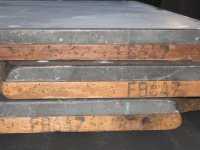There are three models listed here
http://www.brunswickbilliards.com/our_rich_history/antique_tables/centennial.html
Model C:
- Finish: Rosewood satin.
- Rails: Rosewood; side pocket butt joint; no side pocket castings; 3 hole nut plate.
- Slate, 3 piece, 1" thick.
- Rail castings: Polished anodized aluminum: used at corners only; attached to rail by bolt passing through center of face into recessed rail nut.
- Apron corner castings: Polished anodized aluminum.
- Pockets: Maroon; one piece molded rubber.
- Legs: Oval shaped, tapered, rosewood finish with aluminum trim; without stretchers. Attached to base frame by bolts without angle brackets.
- Apron ball rack: recessed in foot end apron; rosewood. finish.
Model C-1: Same as C except:
- Rails: Rosewood with side pocket castings, 5 hole nut plates.
- Rail castings: Polished anodized aluminum; used at corner and side pockets; attached to rail by bolt passing through center of face into recessed rail nut.
- Legs: Oval shaped, tapered, rosewood finish with aluminum trim with stretchers. attached to base frame with angle brackets.
Model D-C: Same as C except:
- Rails: Rosewood with side pocket casting; figure 8 nut plates.
- Rail castings: Polished anodized aluminum; used at corner and side pockets; attached to rail by bolt passing through face into rail angle nut plate.
Pretty interesting that we both have the same model with different pocket casting. My table has corner pocket castings only. I just finished the refurb on mine this week. I can tell my table spent time in a pool hall by the number of ball dings on the stretchers. My castings may not be original. One of the four is void of the screw holes in the casting. I assumed that it was the odd ball. Well you know what's said of assumption.

Ken Hash from Classic Billiards may be able to answer this question.
By the way, do you know the production start and finish dates for the C model?
